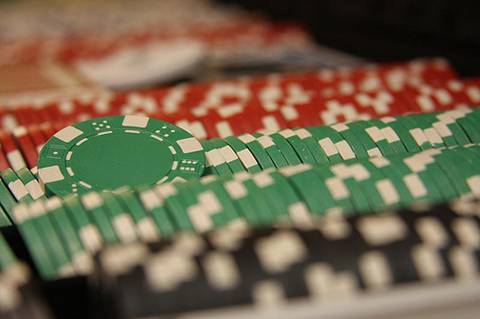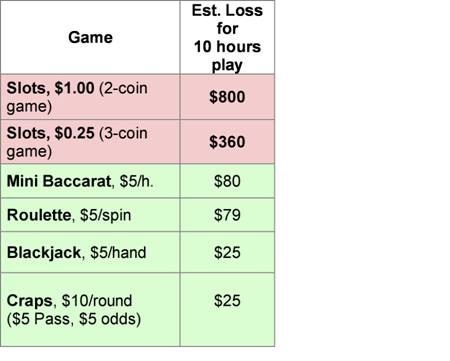 By Jarred Carter, Andrew Cavanagh, Elizabeth Olveda, and Meredith Ragany
By Jarred Carter, Andrew Cavanagh, Elizabeth Olveda, and Meredith Ragany
Vegas baby, Vegas!
So you’ve finally made it out to Sin City, setting aside a few hundreds dollars to gamble. Maybe even a thousand. You’re hoping to get lucky and have some fun. A few hours and a half-dozen drinks into your weekend, you find yourself at the craps table, dice in hand. You’re feeling good, ready to turn your recent down streak into big bucks. Where does that leave you?
Right where the casino wants you.
The game is rigged. Everyone loses money eventually, if not immediately. But just like gamblers grab hold of that lever and pull, society has stepped up to the gambling craze. And now gambling is pulling people for all they’re worth: emotionally, mentally and, most notably, financially.
This post will look more closely at casino’s techniques to draw gamblers back to the slot chairs and the tables, focusing on both physiological aspects and engaged decision making. Ultimately, these observations will demonstrate that casinos create more than entertainment; they develop an entire compulsive experience.
The Gambler’s Rush
The casino’s greatest asset might be the very personal, very intense rush that gamblers experience as they step up to the blackjack table or slot machine, hoping to strike it rich. This characteristic “rush” or “high” stems from the series of steps and actions that are involved in addictive behavior. Stimulation from the surrounding atmosphere and the thrill of a big risk drives the “high”. Ultimately, the “rush” from gambling can be as intense as a drug fix.
Dealing Emotions
Excitement, making a quick buck, or even the possibility of financial independence is enticing. From experience, most people know that emotions are difficult to control. From a neurological standpoint, the amygdala is situated in the limbic system and is one main centers of emotion (pdf) in the human brain. Other parts of the brain, like the prefontal cortex, display less activity (pdf) during the act of gambling.
The response of the limbic system in producing emotion has been supported in studies conducted with pathological gamblers (individuals that exhibit persistent and recurrent maladaptive gambling behavior). A 2003 psychiatric study (pdf) compared the responses of pathological gamblers and control subjects to videotapes depicting happy, sad, and gambling content. Participants rated their emotional and motivational responses in addition to the brain imaging.
For gamblers, the gambling references elicited urges and temporary changes in brain activity patterns in frontal, paralimbic, and limbic brain structures. This evidence points toward a connection between gambling and the limbic system in producing a “high” from an emotional response.
Furthermore, when viewing gambling cues, pathological gambler subjects also showed relatively decreased activity in brain regions associated with impulse regulation. The urges of the gamblers to use (or in this case to go gamble) indicates a signal to engage, not to regulate. Thus, the emotional response that gambling can elicit along with the suppression of impulse control make the gambling rush one fiscally dangerous “high.”
Engaging the Senses
Gambling also engages the senses. Neural pathways extend from sensory locations to the appropriate association areas in our brains. These areas integrate visual, auditory, somatic, and other stimuli into our perception of the world around us. This interpretation of sensory stimuli means that perception is not always reality.
More often then not, the perceived stimulus is different from the actual stimulus. For instance, the multitude of lights and colors seen within the casino are received on photoreceptors as light waves of different frequencies. Ultimately gamblers perceive them as several colors, not waves of energy. In addition, the soothing sounds that are on repeat in the casino hit the ear as pressure waves, quickly interpreted into sound waves.
What we’re getting at is that the atmosphere, which includes the lights and repetitive music, helps in shaping the intended activities and emotions that the casinos want their participants to have. The brain controls emotions, perception, and rational thought. The casino industry uses tactics which seek to manipulate each of these functions, often with devastating results.
So the question is, how do they do it?
Casinos: Experience and Decision Making

With countless algorithms, computer-programmed slot machines, bright lights and enough cameras to protect a small country, casinos work hard to make sure that your gambling experience is both highly predictable and highly profitable. For them.
While the “tricks of the trade ” that casinos use to keep gamblers betting are well-documented (such as absence of clocks or natural lighting, complementary drinks and endless amenities), one of the more intriguing focuses of the casino atmosphere is its encouragement of engaged decision-making. As discussed by William Eadington (1999, pdf), casinos go to great lengths to convince gamblers that they are making rational, reasonable choices with their money while betting.
Eadington provides the example of an amateur craps player who spends three days in a casino, and bets on 1,000 rolls of the dice. Taking the odds of craps into account, the probability that they will be ahead after 1,000 of these craps bets is just 33% (a fact that casinos are well aware of). Casinos must work against the often steep odds that gamblers face in order to keep them gambling. For Eadington, casinos must work to encourage gamblers’ beliefs that they are making smart decisions with their money. To this end, casinos use methods such as slot machines with progressively growing jackpots to promote the illusion that “big money” is just one roll of the dice or pull of the lever away for gamblers.
MIT Professor Natasha Schull describes the casino as a site of “intensified technological stimulation” (pdf), a place where gamblers, amateur and compulsive alike, can lose themselves in their gambling experience. Casinos perpetuate this sensorial gambling experience, as it allows gamblers to enter into what Schull calls a “zone” state, enabling them to “forge an insulated, autonomous space of play in which they can set and reset their own bet level, rhythm, and pace.” According to Schull, the ideal customer is someone who stays until they lose all their money – it’s called “player extinction.”
Once gamblers enter this zone, they can bet for hours without interruption or consideration of the economic value of their decision-making. In order to convince their patrons that they are engaging in productive profit-seeking methods, casinos place a heightened emphasis on engaging gamblers, and making gambling an exceptionally sensorial experience.
Now that you’re in the “zone,” you have everything under control and the jackpot money is yours for the taking…or so you think.
The Illusion of Control
Players literally “hold the cards” in games such as blackjack and poker, providing them the feeling that they have a certain amount of control over events that are, in fact, governed by the laws of mathematics. Just picture the craps player blowing on dice for luck.

Casino chips, for example, are almost laughable in their simplicity. They allow gamblers to part quickly and painlessly with an abstract form of their money. Yet the chips themselves make gambling a corporeal experience – something you touch and control, an idea that sites like Full Tilt Poker actively promote.
Chips must be traded in for cash in order to have any worth in the world outside the exciting casino. Although a seemingly basic task, walking through the casino for a chance to exchange chips may lead to one more game, especially when that certain glowing, beckoning slot machine catches the gambler’s eye. Clearly, casinos use this and other methods to maintain a cycle of continuous, fast-paced gambling while trying to minimize the noticeable effects of losing money for their customers.
In 1975 psychologist Ellen Langer captured the essence of this sort of phenomena when she defined the theory of the illusion of control (Langer 1975). The theory of illusion of control is “an expectancy of a personal success probability that exceeds the objective probability of the outcome.” Langer proposed that this type of overconfidence is likely when an event that is at least partially determined by chance is characterized by factors that normally lead to enhanced outcomes under skill-based situations, such as choice, stimulus or response familiarity, competition, and active involvement.
Applying this theory to casinos, the illusion of control is likely when an individual plays games which are at least partially determined by chance (poker, craps, slots, etc.) and are also characterized by choice (“Hit me!”), competition (beating the dealer), and active involvement (rolling the dice or pulling the lever).
The choice, competition, and active involvement that casinos offer boost an individual’s perceived control over an outcome. According to Langer that leads to an “unrealistic subjective probability of success.” Furthermore, the larger the role that skill can play in determining the outcome (“knowing” how to bet, or performing “winning” rituals) the more pronounced this illusion of control becomes.
In 2006 Langer’s theory was applied to a study done in a natural setting in Reno casinos. In this study, patrons of Reno casinos were observed placing craps bets on their own and another patron’s dice rolls. The hypothesis was that subjects would play riskier by placing higher bets and more “difficult” bets on their own rolls (when they would be under the illusion of control). The results of the study, as well as work on the gambler’s fallacy of the “hot hand” (pdf), help support the Langer hypothesis. The illusion of control is well at work in casinos, and gamblers are most likely losing more money the more they feel like they can affect the outcome.
Against the Odds
But casinos do more than keep you glued to the tables; they set you up to lose. This house advantage grows more likely and inevitable the longer one gambles – it’s the House Edge. Although a gambler may have a “lucky” win, continuing to gamble makes loss almost unavoidable. The techniques of casinos acknowledge this, encouraging gamblers to keep gambling.

From Craps to Keno to Roulette, the house always has an edge that grows more evident as their techniques keep gamblers from leaving the casino. Slot machines, for instance, remain one of casinos most popular draws and clearly demonstrate the manner in which casinos make money. A quarter slot machine, innocently taking only small change from gamblers at a time, results in about a $360 loss within 10 hours. Other popular casino games also post statistics that favor the house.
Clearly, gamblers normally end up paying the casinos instead of hitting the jackpot. It proves easy to look at these numbers when outside of a casino and belittle those who see gambling as a chance to win big. However, when placed in the casino atmosphere, the thrill of entertainment and the seemingly endless possibilities encourage gamblers to go for that one “last” game.
Maybe you could become a millionaire against the odds. But, once removed from the stimulation of casinos, it becomes much easier to acknowledge that the house ultimately wins.
Casinos play the odds, people play the games. In the end, that means the casinos play the people.
For more information:
Getting Help for a Gambling Addiction
The National Council on Problem Gambling
Problem Gambling – A Canadian Perspective
Gambling Industry
Stop Predatory Gambling Foundation
Research
E-Gambling (Journal of Gambling Issues)
Institute for the Study of Gambling and Commercial Gaming
Cambridge Health Alliance Division of Addictions
National Center for Responsible Gaming
Video Resources (YouTube)
Winning at Slots
Winning at Roulette
Losing at Slots
Losing – “He took everything”
Excalibur Walk-in – see the casino layout
Compulsive Gambler’s Recovery Story – “You always lose more than you win”
Compulsive Gambler’s Story & Critique of Industry – “an ex casino gambling degenerate”

Thanks very much for the info. I have to say that I agree with the above
Great information! I’ll sure my uncle reads this. I hope this can help him realize to control his gambling.